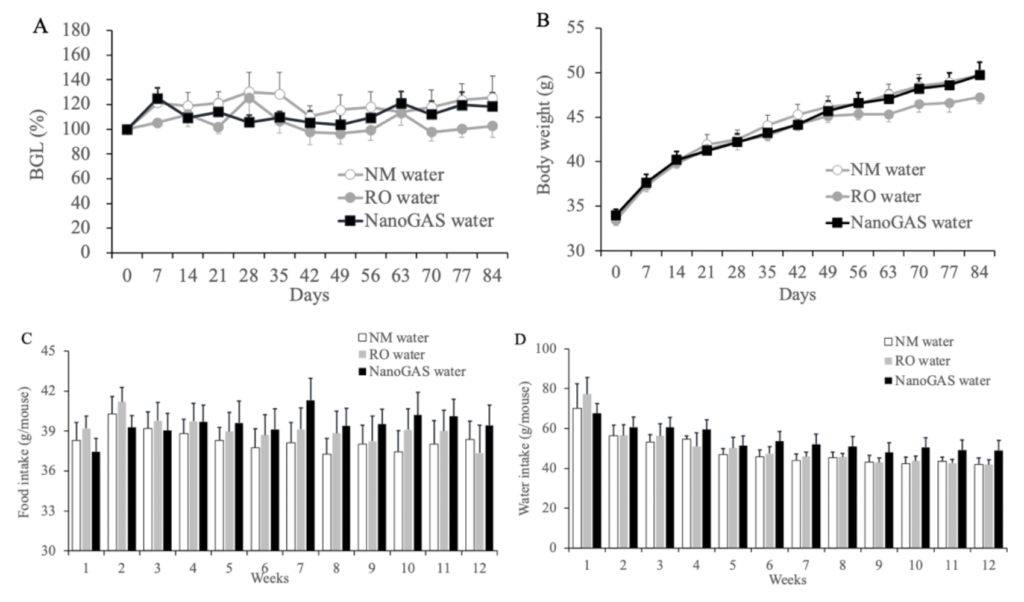Original Research Article] “Bio-Safety of “NanoGAS Water” for Long-Term Drinking” has been published.
Mar. 20, 2023
Morishita R, Shimada M, Nagao M, Shimizu S, Kamei N, Takeda-Morishita M. In Vivo Proof of Biological Safety and Physiological Effects of Orally Ingested In Vivo Proof of Biological Safety and Physiological Effects of Orally Ingested H2-Filled Ultrafine Bubbles (UFBs). Biol Pharm Bull. 2023;46(2):343-347.
https://www.jstage.jst.go.jp/article/bpb/46/2/46_b22-00631/_article
[Background and Purpose]
Due to their special physicochemical properties and diverse biological effects, microbubbles have recently been exploited for industrial and biological purposes. Therefore, in this study, we decided to verify the safety of microbubbles on living organisms with a view to their future use in the health science field.
In this study, H2NanoGAS®, which can retain hydrogen in liquid for a long time, was used, and mice were randomly assigned to three groups: H2NanoGAS® water, reverse osmosis (RO) water, and mineral water (MW), and fed ad libitum for 1 month or 3 months.
[Verification method]
Untreated male ddY mice were fed H2 NanoGAS water, mineral water (MW: Natural Mineral water), and RO water made from NanoGAS for 1 month and 3 months, respectively, and blood and histopathological examinations were performed on the last day of rearing. The 1-month rearing group had blood glucose levels measured only on the first and last day of the study.
Result
Table 1 Blood biochemical parameters following 1and 3 months oral intake of NM water, RO water or NanoGAS® water

No parameter variation was observed among all groups in blood tests, and no significant differences were observed, indicating no disability.

Figure 2 Effect of 1 month intake of NM water, RO water, or NanoGAS® water on BGLs, Body weight, amount of food intake, and amount of drinking water in normal ddY mice. (A) BGLs, (B) Body weight, (C) Food intake, and (D) Water intake. Data indicate the mean ± S.E.M values (N=3-4). Data of drinking water of NM water on week 1 was N=2.
There were no significant differences in blood glucose levels, body weight, food intake, or water consumption among the one-month rearing groups.

Figure 3 Effect of 3 months intake of NM water, RO water, or NanoGAS® water on BGLs, Body weight, amount of food intake, and amount of drinking water in normal ddY mice. (A) BGLs, (B) Body weight, (C) Food intake (N=6-7), and (D) Water intake (N=3-7). Data indicate the mean ± S.E.M values.
There were no significant differences in blood glucose levels, body weight, food intake, or water consumption among the 3-month rearing groups. In the second half of the observation period, slightly higher food intake was observed in the NanoGAS group, but the body weight trend was the same as that of the NW group, suggesting that NanoGAS or hydrogen may have had an effect on nutrient absorption efficiency.

Figure 4 Effect of 3 months intake of NM water, RO water, or NanoGAS® water on cumulative food intake in normal ddY mice. (A) Cumulative food intake in the first half of study period (Weeks 1-6) and (B) Cumulative food intake in the latter half of study period (Weeks 7-12). Data indicate the mean ± S.E.M values (N=6-7).
Comparison of food intake of 3-month rearing groups in the first and second half of rearing.
While growth-promoting effects have been observed in oxygen (Ebina K, et al., PLoS One, (2013)), hydrogen is known to have hypermetabolic rather than growth-promoting effects, which may be related to increased food intake. However, since there are no direct reports of hydrogen promoting growth, detailed studies are needed to estimate the potential biological effects of hydrogen-filled UFB water.
[Conclusion]
Oral ingestion is currently the most common method of supplying hydrogen to living organisms.
From Henry’s law, it can be calculated that saturated hydrogen water in an approximately 500-mL container at room temperature and atmospheric pressure release will reduce the hydrogen concentration by half after two hours.
This study examined the biological safety of H2-encapsulated microbubbles in animals during subchronic periods (1 and 3 months) of drinking, with the aim of future applications in health science. These results showed for the first time that H2 NanoGAS water has no toxic effects on living organisms, indicating its biological safety.
It is also suggested that drinking H2 NanoGAS water may be related to appetite enhancement, and further research on such physiological effects is expected in the future.